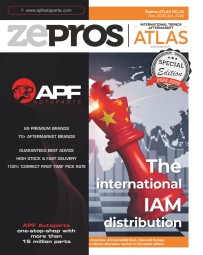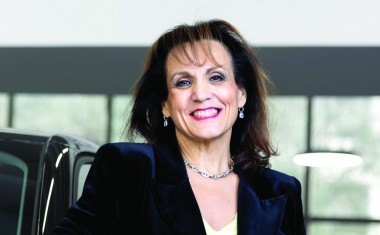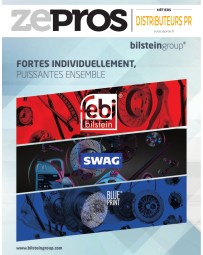
S. Layec, Stellantis: “Our philosophy? The customer first!”

Stellantis’ Dare Forward 2030 global strategy is systematically advancing its pieces and disrupting conventions at every level of its organization. Emphasizing pragmatism over dogmatism and prioritizing the customer, whoever they are. Manufacturer and independent spare parts are key elements of this approach.The strategy is fueled by the consistent mantra of “Think global, act local”, creating a path that aims to position Stellantis Parts & Services as a major player in parts distribution. Sylvie Layec, Senior Vice-President Parts & &Services, global Sales & Marketing, provides insights into these developments.
Could you elaborate on your highly focused strategy based on customer typology (BtoC and BtoB) at the international level?
Sylvie Layec: Certainly, we are expanding our already well-tailored 360° approach to meet the demands of the spare parts wholesale and repair market. A significant development involves incorporating category managers (CatMan), who gather all customer expectations for products and services through various information channels. We initiated a European pilot to validate and enhance the concept, now operational globally, before expanding to North America and all regions in 2024. The primary objective remains unchanged: prioritising the customer! Everything stems from their needs, recognising the substantial variations based on whether they are an end consumer or a professional distributor, authorised or independent repairer or fleet manager. Remaining firmly “customer-centric”, we’ve assigned category managers to each product segment, tasked with crafting the most fitting offers for each customer segment. The overarching goal is consistent: providing a comprehensive range of parts, services, and solutions throughout the vehicle lifecycle, with a strong emphasis on availability. Our strategy aligns more than ever with the one-stop-shop approach!
How is this strategic evolution broken down?
S.L.: It comprises five essential pillars: a highly comprehensive product and service coverage for the repairer, structured around the “good-better-best” model to support the vehicle throughout its lifecycle, incorporating circular economy components. This necessitates a well-positioned and competitive pricing strategy, driven by “price for value”, appropriate product ranges, and logistics ensuring both availability and local delivery. Following these are commercial activities and “go to-market” initiatives tailored to each customer typology in different world regions, whether they are distributors or repairers. These initiatives include, among other things, loyalty programmes, marketing, training, and market intelligence.
Our CatMan organisation is global, but everything starts with the customer’s needs. The one-stop-shop remains the guiding principle.
The category managers are already present ...
S.L.: Their role is distinct at Stellantis, encompassing both OE parts and aftermarket components, including our private label and elements sourced from the circular economy. There is no equivalent that is as comprehensive and cross-functional to ensure the distribution of spare parts for the fourteen brands within the group, including our private label programmes such as Eurorepar, bproauto®, and our multi-brand aftermarket ranges. This system further solidifies our position in a globally aging vehicle fleet (over 11 years on average), except for China, where the average age is 6.8 years.
How can a lasting IAM strategy be crafted in the face of a growing electric vehicle market?
S.L.: According to Frost & Sullivan the parts distribution market is projected to reach $603 billion by 2027 [wholesale prices], indicating a substantial growth of 38% compared to 2022, translating to an annual growth rate of 7.6%. Notably, China is set to play a pivotal role, accounting for 21% of the global aftermarket by 2027. We are pursuing multiple strategies to meet the evolving needs of a diverse fleet in terms of age, quantity, brands, and types of vehicles on the road. As part of our real-time calibrated 360° offering, we have seamlessly integrated a comprehensive circular economy approach for batteries, covering repair, remanufacturing, reuse, and recycling of end-of-life batteries. Our commitment to sustainability is evident with the inauguration of our first circular economy hub in Turin and the introduction of our hybrid and electric label within the Eurorepar Car Service network. At a recent exclusive showcase at Solutrans (France), we unveiled a 100% retrofitted vehicle. Simultaneously, there is a remarkable surge in the adoption of environmentally friendly engines, encompassing hybrids and fully electric vehicles. Regarding the latter, the global BEV (Battery Electric Vehicle) fleet is projected to reach 6% by 2030, with significant regional disparities: 20% in Europe and 22% in China! The escalating trend of urbanisation is expected to impact 60% of the global population by 2030 and rise to 68% by 2050. Consequently, mobility demands are undergoing a profound transformation: the shift from ownership to usage or on-demand vehicle consumption is propelling the market share growth of fleets. It is these fleets that are hastening the switch to electric and/or hybrid. We believe that the estimated 22% electric vehicle fleet in Europe by 2030 could potentially accelerate towards 30%! Given these social and economic dynamics, we must adapt our offerings almost in real-time because, once again, everything originates from the customer and their needs. Our guiding principle is straightforward: customer first, regardless of the circumstances!
Could you provide more details on the significant variations by region for electric and hybrid vehicles?
S.L.: The prevalence of these vehicles in the automotive landscape is expected to triple by 2026: 20% in China, 18% in Europe… but merely 1% in Mexico! In the United States, the Inflation Reduction Act, enacted last August, amplifies incentives for purchasing environmentally friendly vehicles produced domestically. Across Europe, the market share of BEVs stands at 26%, with projections suggesting it could escalate to 75% by 2026. Brussels has mandated the cessation of ICE vehicle production by 2035. Nevertheless, the landscape remains dynamic and subject to change based on individual local regulations!
Is the acquisition of Norauto in Argentina indicative of upcoming acquisitions?
S.L.: This recent acquisition perfectly reflects the pragmatism and nimbleness of our conquest ambitions! Norauto Argentina has been established in South America since 1998, boasting thirteen centres and workshops situated in the province of Buenos Aires. We plan to continue our expansion in Argentina, and simultaneously, we aim to extend this broad conquest to other regions, spanning all segments of the aftermarket. It’s worth noting our acquisition of Chinese distributors, a move that has positioned us as the fourth major player in the worldwide aftermarket. Our joint venture with the Chinese electric brand Leapmotor, intended for global deployment, exemplifies our dynamic approach within the Dare Forward 2030 strategic plan. China is witnessing a rapid transition toward fully electric vehicles, by passing hybrids, driven by 150 predominantly local manufacturers. To us, it represents an open-air cluster of opportunities!
Figures
• In Europe: 147 Distrigo Hubs (+19 compared to 2022), 520 Distrigo Relay and Markets (including 170 Distrigo Relay, 350 Distrigo Market), representing an increase of 133 compared to 2022.
•6,192 Eurorepar Car Service locations in 30 countries (+423 compared to 2022) as of the end of November 2023.
Click here to access the 2024 International IAM Distribution Atlas






